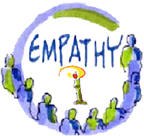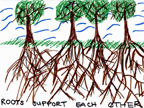|
|
|
Conference
- Panels
-
Possible Panels
- Facebook
Event -
Education -
Volunteer - [Planning]
Index:
Panel 001-B
(Video Transcriptions: If you would like to take empathic action and create a transcription of this video, check the volunteers page. The transcriptions will make it easier for other viewers to quickly see the content of this video.) Transcriber - Roshni Ladny thank you for this transcription. DONE!
Edwin: -Welcomes panelists - Introduces topic : Empathy as it should exist in educational system.
Sherry: Hello everybody, as we have our conversation today. I am curious, what is it that brings you to this discussion on empathy and education today? Is there something in particular that comes to mind? What is motivating you to be here today? Who would like to start?
MI: What I think about empathy and education is that it CAN be taught. I am looking for the lessons to be a universal outpouring because we really need empathy in all areas of our lives. Sherry: So it is possible to teach empathy and there are specific ways that it can be done. Ilene, how about you?
IF: I have been involved in teaching empathy in various forms for the last 15-20 years. I am still grappling with which best practices can be taught that kids can connect with right away.
SM: Devotion to this cause How can empathy be sustainable Specify how empathy can be sustainable Challenge is: creating cultural container of framework that allows empathy to be held in community. Otherwise it dissipates Keeping empathy alive Framework that culture holds, How it is acted out, not just taught is important, Container of empathy must be kept in place
ER: Learning from different modalities on empathy. From books to nonviolent communication Have learned more about it myself Empathy was lacking in schools at one point. Mediation training would have been handy. Learning this at young age can serve a person for life. Conflict resolution.
SM: Important to bring that concept in. Empathy means different things to different people. How does that relate to education? How does one’s understanding of empathy relate to education?
MI: Definition: ability to be reflective and understand another person’s emotions, the circumstances they are going through. Also, to have some sympathy for them, and be able to step out of oneself in order to do it in order to understand another.
SM: Even if one’s circumstances are different from another, the person is able to understand how things are for the other person. Transcending our circumstances in a way and seeing our common humanity
IF: Not only being able
to walk in another’s shoes, but being able to take your shoes off and
step into theirs. Being able to step into curiosity and unknown in order
to really hear and feel another person’s experience, without filtering
it through your own experiences. We don’t really have a shared definition. Technical definition_ cognitive, affective, empathetic action Empathy as value: We value everybody’s experience.
SM: Caroline Casey talks about how in order to be affective, we have to be able to hold more than one reality at a time. Humor- multiple meanings and perspectives
ER: Encompassing definition
ER: 8 ways that empathy is used in society- included as overlapping with compassion and sympathy.
SM: Educational context
SM: How to create conditions for empathy in educational context?
IF - Looking at underlying knowledge and skills required - How specific programs impart certain skills and knowledge - Example is “Roots of empathy” that is really effective and different from other programs
SM: I want to hear one specific way that you are aware of that creates conditions for empathy in education, regardless of the program. What works? MI: What is the purpose of empathy? What is the cause of the need for teaching empathy?
I think that empathy needs to be learned everywhere. It addresses a core issue that we have not talked about yet. It is a place to resolve and unite.
IF: Why we are compelled to discuss empathy in school setting:
This is a public health issue (discusses example of kids fearing coming to school b/c of fearing what others will say/do.) We must create schools in which kids feel safe and can get along. Otherwise the host of negative issues that occurs there will continue to happen.
SM: Empathy is important in addressing differences among people. We need to develop our empathetic skill to deal with differences.
MI: I have been doing diversity work for 30 years now. It is about valuing diversity. We deal with our own personal wounds and have enough self reflection so we can sit across from someone completely different. This way we have already dealt with whatever would have caused me to reject the different person. - Self reflection part of empathy - Accept person who is very different - See them without trauma strings attached to self that can cause distorted perception of other
SM: So an actual conscious way of doing self-reflection. Working with that will help support the goal of being connected to others?
MI: (Gives example of an activity that diversity training provides). People can have stereotypes, but also address why they exist, and how to change them through addressing why we think what we think. My goal on the large scale is to help society see that we live in a culture of pollutants. It has to do with the way the system is set up. A lot of these pollutants have to do with stereotypes, underclass population, and racism. By teaching empathy we can bring down the walls that have been built that divide races and classes.
ER: Is the process for breaking wall down a process of inner dialogue and dialogue with others?
MI: Yes, it would start with “Who am I”? “: I can see myself for who I am but differentiate myself from my basic group(more than just being black, white, or brown, or rich or poor). This is the part of self reflection. The goal is to see that you are unique person who just happens to be part of a group of people. This allows us to be open to other groups and address emotions that arise within us such as fear.
SM: I am really struck by what I hear from what I have heard from adolescents in a secondary school context about bullying. Their experience of bullying is all based on differences. They recognize that is all based on differences. There is this idea that empathy is about just getting along and ignoring differences. I am just curious if there is a way that having that message sent on how ignoring differences somehow feeds bullying.
ER: I am hearing that there is a common sense of humanity. Common humanity and uniqueness mix together. It is important to be able to see both.
- Focus on conformity: What it means to be good, cooperative, how we are all alike - Easier to talk about than addressing deep differences like racial and class differences, and sexual orientation. - These seem to be connected to people’s values. - Neutrality laws on teachers being able to remain silent when these deep difference issues come up.
- Must help child realize that they can shift from family environment to school environment in which they feel safe. This involves addressing the student and the problem. This involves empathy. - Some teachers did not make space for students and their problems. They did not want to implement community setting of where children could be heard. These classrooms had more problems.
- Teachers are role models. Teachers must be able to see this and how their expectations affect child - Low level expectations affect child and impede child - Empathy helps with teachers’ attitudes around children - Teaching teachers as well to be empathetic
IF: Implementing just a classroom program to teach empathy will not be affective, therefore NOT sustainable. (Critical to have a “container”). This will allow sustaining of empathy.
Container of empathy
Center of container: community of empathy Connecting components to center: Programs to teach empathy Cooperation Other curriculum focused on Training of staff in empathy Manner of discipline conduction in classroom - All of these must come together-
MI: (Discusses examples of training teachers in how to relate to the children. Teaching the teacher to clear stereotypical thinking and giving child a chance) - Discussing “mystery questions” is part of creating a safe environment. Mystery questions include: is there a god, what happens when I die. -One person at a time, one child at a time-
SM: Circle of empathy for support for teachers is needed.
How will we go forward with other questions to explore that are more detailed?
IF: In roots of empathy, the teacher is actually a baby. I am instructor there to facilitate. Another person helps us understand how concepts relate to ourselves. The brilliant thing is that babies do not have filters the way older people do. This erases prejudgments and stereotypes coming into play. It is a relationship, therefore, of total acceptance. Kids in the program get excited to see the “baby” and vice-versa. There are no hidden motivations. This allows kids to access a pure experience of empathy that most other programs don’t.
What it comes down to, regardless of programs- tribes or any other programs, it comes down to time. Teachers do not have time to implement this because of all the other tasks such as keeping up test scores. Teachers are not paid for the time this would take. People understand the cognitive value of empathy, but it is another thing to fit it in (time-wise). This must be equal to other priorities such as literacy and math. The desire to do this must be there.
Is there anything else that anyone wants to add?
Post Panel Discussion
|
|
||||||||||||||||||||||||||||||||||||||||||||||||
|
||||










